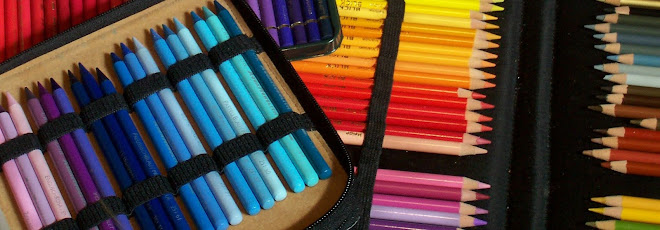Product photo Pentel Arts Color Brush Set in box
I tossed this into my last Blick order on a whim. I had meant to try the Pentel Aquash water brush and see how it stands up to Niji, Sakura and other favorites. It's included in this sketch pens set - so I thought, well, let's see how convenience works. A black, sepia and gray sketch brush prefilled would be handy for sketching.
Wow. I didn't realize how good the Pentel Arts brush would be or how great a point it'd have. The color pens come with cartridges, when they're used up you can get black refills. The gray and sepia only come in sets. Still the set was moderately priced at under $18 at Blick, so it's not that bad for a water brush and three pens. Comparable to other water brushes, certainly.
The color pens unscrew clockwise and screw back on counter-clockwise. This was the case with some water brushes I've had in the past. The Aquash works in the other direction. Get used to it, these things aren't going to be standard in screwing and unscrewing. It's fairly easy to tell if you get it wrong. They come with a little plastic protective collar to keep the cartridge from fully engaging till you unpack it and remove that, which probably keeps the points from getting gunked up before you even use it. I liked that.
The brushes on the color pens are actual brushes with hairs, like a proper water brush. They aren't fiber tip brush tips like the Pitt Pen Big Brush or the Tombow Dual Tip brush tips. They hold a lovely fine point. I got wonderful expressive details with them and did a little lettering on another practice sheet that came out well.
But their real joy came in the painting!
Painting done with product: shaggy dark goat on a hollow log in a dramatic pose as if it just knocked another goat down.
I had a good photo reference and thought, let's see how these do for illustration. Wow wow wow. Beautiful points. Beautiful expressive strokes. They are very juicy. Before I added the black strokes I had some interesting effects when the gray puddled and lightened in some areas. It handles like watercolor or thin ink, and the pens are good and juicy. I got dry-brush effects sometimes though.
When the brush starts giving dry brush effects, a squeeze on the handle will give more ink. They handle a lot like other water brushes that way. Except that three of these are loaded with color and it's good color. The gray is light enough to stand a second layer to deepen it for another tone, without going to black. So light-dark effects either wet in wet or wet over dry are easy once I got the feel for it.
A black cat painting shows how I got the gray to handle values:
When the brush starts giving dry brush effects, a squeeze on the handle will give more ink. They handle a lot like other water brushes that way. Except that three of these are loaded with color and it's good color. The gray is light enough to stand a second layer to deepen it for another tone, without going to black. So light-dark effects either wet in wet or wet over dry are easy once I got the feel for it.
A black cat painting shows how I got the gray to handle values:
Graveyard Watch, black cat on light tombstone against dark forest
The highlight on the cat's belly was achieved with a second layer on the cat's body, wet over damp. It wasn't completely dry so came up slightly soft edged, while I got deeper darks next to the stark blacks that I put in with the Pentel Pocket Brush pen. The combination of waterproof Pentel Pocket Brush Pen and Pentel Arts Color Brush watersoluble brushes gave me great flexibility in this piece. I got the deepest darks in first and washed over them confidently without breaking any crisp edges, then toned with the gray Pentel Arts Color Brush.
It's very delicate and the ink dries semi-washable. It's not fully dissolved when I run water over it - when it's dried, as the lines were in the brown part of the sawn hollow log, running water over them created only a very light wash. This can be really handy for sketching. Do loose strokes very close together and it will start acting like a wash, color flowing in the direction the paper's slanted.
They are extremely expressive. How they feel in the hand is a delight. They invite expressive strokes and experimental techniques. I rate these pens five star. They don't have the flat effect that the Tombow ones do, because the color does run lighter or darker depending on moisture. This makes them much more like sumi-e painting (Japanese ink painting) and allows for some gorgeous effects.
I loosened up using them, but still got as much detail as I wanted in tight areas like the animal's eye or the contour of the ear.
The brush on the Aquash water brush is excellent, with good flow and a lovely point. I'm sure this will become one of my favorites. Slightly sharper point than the Niji and I like the way the ginger-jar handle shape keeps it from rolling off the desk. It's compact and handy. The one included is a size Medium but they also come in large, small and I think there's also a flat one. Similar to other water brush products in pricing, the handle doesn't have the flow regulator in it so filling is very fast and easy - the regulator's up in the tip.
Urban sketchers should really love these. Throw them into your kit and see what comes out in your journal!















